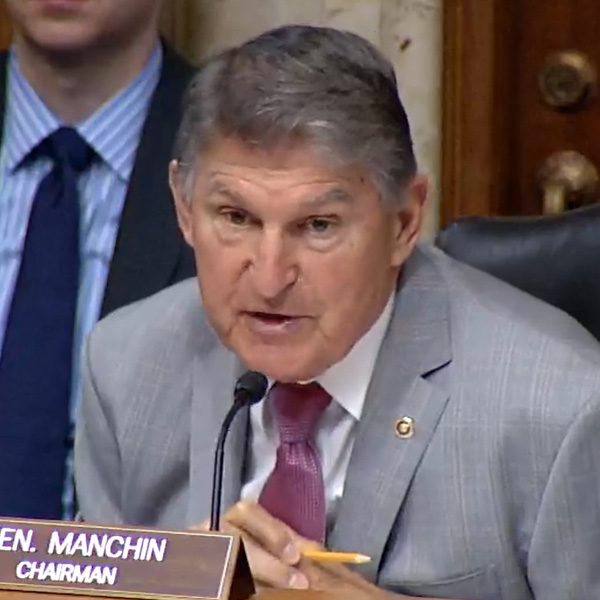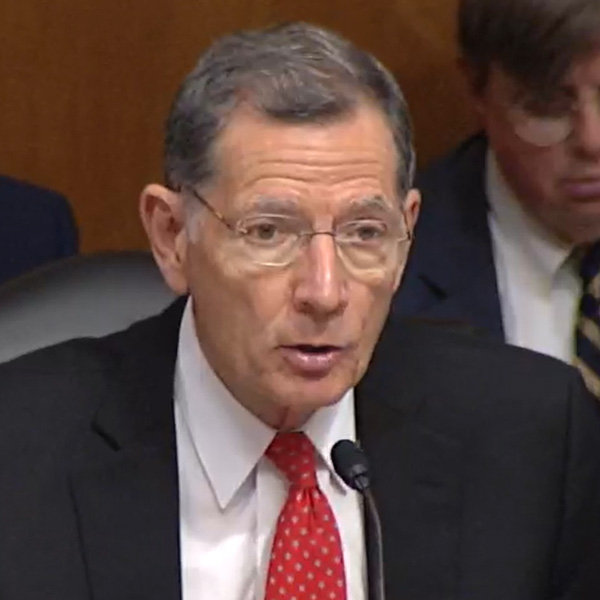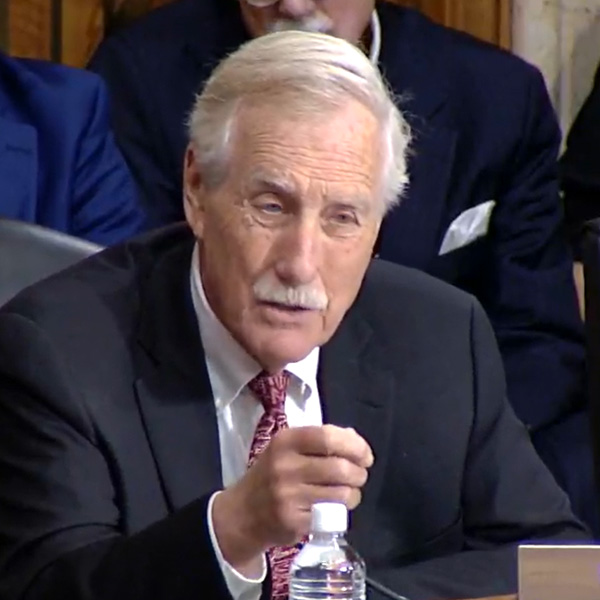The ultimate future of FERC Order 1920 depends on rehearing, implementation and inevitable litigation, but after reading through the order itself in the past week, many stakeholders see it as an important step forward in expanding the grid.
FERC issued the 1,364-page order on a 2-1 vote May 13, with Commissioner Mark Christie (R) filing a dissent and countered by a joint concurrence from Chair Willie Phillips (D) and Commissioner Allison Clements (D). (See FERC Issues Transmission Rule Without ROFR Changes, Christie’s Vote.)
The order requires regional transmission planners, including ISOs and RTOs, to plan at least 20 years ahead of time using multiple scenarios while taking into consideration several benefits. Their cost allocation plans for projects must ensure only customers who receive those benefits pay for the projects.
“The status quo is not working, and this stuff is hard,” former FERC Chair Neil Chatterjee (R) said. “I think that Commissioner Christie raised a lot of significant points in his dissent that I need to think through. I think he’s probably right on a lot of it. But the reality is, somebody’s got to make a tough call. And I commend Chairman Phillips for making the tough call here.”
Chatterjee said the issue has bounced back and forth between Congress and FERC, and one of the two needed to act to move the ball forward.
“It’s a 1,300-page order; there is a lot to unpack,” Chatterjee said. “But from what I know of it to date, I honestly believe had I still been on the commission, I would have voted for it.”
Outside of claims that the order is aimed at implementing President Joe Biden’s green energy policies, much of Christie’s concerns have to do with the impact on consumers. Devin Hartman, of the conservative think tank R Street Institute, argued that consumer response to FERC’s rule would determine how far his arguments go.
“The big thing will be whether the consumers see the proactive and more comprehensive benefits approaches as leading to more economical transmission development than the status quo,” Hartman said.
Regional economic transmission projects have generally done well on the cost-benefits front, saving consumers plenty of money, but consumers have been against the general rise in transmission rates, as most spending in recent years has gone to local projects that address specific reliability needs, he added.
The National Association of Regulatory Utility Commissioners expressed disappointment with “the significantly diminished state role” envisioned in Order 1920. But the organization represents 50 states, and some of them are supportive, such as Michigan Public Service Commission Chairman Dan Scripps.
“You’re going to have a trade-off any time you do interstate infrastructure planning on a consistent basis across state lines; you’re going to gain more efficiencies, but you’re going to lose some autonomy of those states,” Hartman said.
The Electricity Consumers Resource Council, which represents large industrial customers and is “resource-neutral” in outlook, found the rule to be generally positive for consumers, said CEO Karen Onaran.
But Onaran’s predecessor, Travis Fisher, who is now with the Cato Institute, wrote a critical take that argued Order 1920 represents FERC putting its thumb on the scale to help build out renewables.
It is unfortunate that the partisan politics around green energy have “hijacked” the transmission issue because the grid needs to be expanded regardless, Onaran said.
“I think for the Republican side, we just need to emphasize — especially as industrials are looking to expand their operations onshore in the U.S. — we’re going to need reliable service,” Onaran said. “And we’re going to go to those regions that have favorable regulatory policies that do look at expanding the grid that can support our operations, regardless of what the generation choices or availability is; we’re just going to need to get access to a lot more energy.”
Even when it comes to the grid’s transition to more green power, Chatterjee said he sees the politics eventually working itself out.
“I do think in the coming years that we will get to a point where red supply is feeding blue demand,” Chatterjee said. “Where you have a lot of this renewable capacity is in red states, and the demand for that clean energy is going to be in blue states. And I don’t think I’m being naive about this; I think that will fundamentally alter the politics around climate.”
While Chatterjee did not like how the Inflation Reduction Act was passed in Congress, it was good policy to onshore the supply chain for renewable energy, which should help make that future possible, he added.
How the Rule Will Change Cost Allocation
Supporters of the rule see little difference in transmission built for renewables, or that needed for reliability and economics.
“It’s not any one driver behind it; it’s multiple drivers,” said WIRES Group Executive Director Larry Gasteiger. “And I think even if you exclude one of those drivers, you still have plenty of other things that are pushing the need for more transmission. There’s going to be some overlap between some of them. If you build a line to deal with a clean energy mandate or integrating more renewables, you may wind up getting more resilience out of the system and enhanced reliability; you may be able to meet some increasing load needs.”
That has already played out, with the lines New Jersey is paying for under FERC Order 1000’s State Agreement Approach to interconnect its initial tranche of offshore wind farms, Abraham Silverman, of SilverGreen Energy Consulting and a former state Board of Public Utilities staffer, said in an interview.
“When PJM did the modeling for the State Agreement Approach that New Jersey ultimately selected, they determined that they were benefits in … three other states,” he added.
Under the currently effective transmission planning and cost allocation regime in PJM, no other option is available, and New Jersey will have to pay for all of those transmission lines despite benefits flowing to other states. Order 1920 requires PJM to plan for binding state policies like New Jersey’s offshore wind targets.
“Now there’s an option on cost allocation, which is if the project meets certain benefit-to-cost ratios, then the costs are socialized across the entire grid,” said Silverman. “If the proposed project doesn’t meet the 1.25 benefit-to-cost ratio, then states can get together and voluntarily allocate those costs.”
States will have a chance to decide how such lines are allocated, but Silverman said that if they were to just stick to the current SAA, then the commission could reject that because it would leave beneficiaries that are paying nothing.
“Now, they’re only required to pay up to the benefits that they receive, and we’re not talking carbon benefits, or anything else,” Silverman said. “We’re really talking production cost; reliability; other sort of very tangible benefits.”
Grid Strategies President Rob Gramlich likened the dispute between the three commissioners on cost allocation to getting the check after group dinner.
“The way I think it’s easiest to think about is if you’re at a restaurant, should you pay for what you eat, or should you pay only for what you ordered?” he said on a webinar with reporters. “And one commissioner thinks you should only pay for what you ordered. And … the majority said, ‘No, you have to pay for what you eat.’ And it’s really just that very basic principle.”
Part of the reason the majority allowed regional planners like RTOs to file their own cost allocation rules that could even overrule the states is because legal precedent from a 2002 case, Ari Peskoe, director of Harvard Law School’s Electricity Law Initiative, said in an interview.
“Basically, the Federal Power Act is written in such a way so as to give transmission owners the right to file any changes in their rates,” Peskoe said. “And so, FERC was concerned that if it gave the state regulators equal rights, it might be infringing on the utilities’ rights to file rate changes.”
Commissioner Christie argued that legal precedent would not be a problem in litigation if states got the right to file cost allocation rules of their own. Peskoe said he agreed with that interpretation.
While that would mark a big change for PJM and some other markets, Brattle Group Principal Johannes Pfeifenberger said that MISO’s Multi-Value Projects have proved very popular even with red states in its footprint.
“MISO did a good job explaining how their states benefit from the Multi-Value Projects, and then has also shown that the portfolio of projects they have come up with benefits each state more than the postage-stamp cost allocation,” Pfeifenberger said.
How Far Will Regions Take the Rule?
One open question is how the rule will be implemented in different regions.
Order 1000 required changes to transmission planning and cost allocation around the country, but only some regions effectively used it to cooperatively build out their grids.
“FERC can take the horses to the water but can’t make them drink,” Pfeifenberger said. “How the regions respond to it will be different, no doubt. And some of them will take this as an opportunity to really improve the planning process to create low-cost transmission solutions. And other regions will just comply with the letter of the order and implement processes on paper that don’t really do anything in the real world.”
The regions are going to have a lot of discretion to implement the rule, which is the case for nearly every major FERC rule, said Silverman.
“How you quantify benefits is going to be something that each individual public utility transmission provider is going to have to do,” he said. “How you incorporate some of the more discretionary pieces of state policies into the transmission planning — the scenario-building process is going to be absolutely key. And then, of course, at the end of the day, you are only as good as the desire to build new transmission.”
The rule gives regions more tools in the toolbox, but it does not necessarily require their use, he added.
Former FERC Chair Jon Wellinghoff (D), who ran the commission when it issued Order 1000, agreed that it was time for an update to its transmission rules.
“FERC just needs to ensure … that those rules are adequately drafted so that there is clear direction to the ISOs as to what they should be doing,” Wellinghoff said. “I mean, FERC has tremendous power there.”
The chair can convene the ISOs and RTOs and other regions and explain what the commission expects to see as its rule is implemented, he added.
Wellinghoff also argued that FERC needs to ensure that Order 2222 is fully implemented alongside Order 1920, as the growth in electric vehicles and other distributed energy resources needs to be fully accounted for. With millions of EVs hitting the road in the coming years, FERC needs to get that rule right so they can be an asset to the grid instead of a burden on it, he said.
Rehearing and Appeal?
A rule this far reaching is going to have requests for rehearing, likely even from parties who largely support it but want to see something changed.
For example, while WIRES supports the planning and cost allocation changes, Gasteiger said it was disappointed the final rule did not go as far on reinstating the federal right of first refusal as the proposed rule did.
Christie’s dissent lays out a “great roadmap” for parties who support his position to follow on appeal, Chatterjee said.
One major issue on appeal is which circuit court gets the case, noted Harvard’s Peskoe. Opponents of federal rules like to go to the 5th U.S. Circuit Court of Appeals in Texas because it has handed down decisions against Biden administration policies previously, he said. But to get it appealed to a specific circuit, opponents need to find an appropriate party located in its territory.
Most FERC cases are adjudicated in the D.C. Circuit Court of Appeals, and the commission likely would prefer it there as the judges have experience with the issues, Peskoe said.
Another major issue is the changing precedents in federal courts, with the Supreme Court considering cases that could overturn the Chevron doctrine of deference to “expert agencies,” which is how the D.C. Circuit upheld Order 1000. (See Supreme Court Hears Oral Arguments on Overturning Chevron.)
“So, it’s possible that the litigants will attack first authority in this case, use this rule as vehicle for a broader attack on FERC that could undermine flexibility to regulate utilities going forward,” Peskoe said.
Christie raised the Chevron issue in his dissent, and he also argued FERC’s rule went against the newer “major questions doctrine” that came out of West Virginia v. EPA (which was argued by FERC nominee Lindsay See, solicitor general of West Virginia).
Litigation against FERC rules of this size and scope is almost a “rite of passage,” Americans for a Clean Energy Grid Executive Director Christina Hayes said on a webinar hosted by the American Council on Renewable Energy.
Order 1920 is built on nearly 30 years of precedent dating back to Order 888 that have opened up the grid and led to significant cost savings for customers, enhanced resource adequacy and other benefits, she said.
“This is built on very stable ground in that there’s so much significant precedent supporting it,” Hayes said. “Were this to be overturned, it would really remake the electrical industry and in ways that are hard to contemplate. For that reason, for the stability of the system, I imagine that there are significant forces that would support upholding this rule.”


